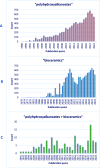Bacterial-Derived Polyhydroxyalkanoate/Bioceramic Composites in Clinical Practice: State of the Art and Future Perspectives
- PMID: 40690593
- PMCID: PMC12344651
- DOI: 10.1021/acsbiomaterials.5c00407
Bacterial-Derived Polyhydroxyalkanoate/Bioceramic Composites in Clinical Practice: State of the Art and Future Perspectives
Abstract
This review examines the current advancements in and potential of bioceramic/polyhydroxyalkanoate (BioC/PHA) composites, emphasizing their growing role in biomedical applications. The integration of PHAs─biodegradable, biocompatible polymers from a bacterial origin─with bioceramics like hydroxyapatite or bioglass offers a unique synergy, combining the structural integrity of ceramics with the tunable properties of PHAs. Such composites demonstrate significant promise in bone tissue engineering, cartilage repair, and drug delivery systems, where they support cell attachment, proliferation, and targeted therapeutic release. The review highlights various methods of manufacturing these composites. Additionally, the review addresses challenges in production scalability, cost, and material purification necessary to meet medical-grade standards. Advances in functionalization, such as drug incorporation and bioactive coatings, are discussed as pathways to customized therapeutic solutions. This review underscores the transformative potential of BioC/PHA composites in creating sustainable, multifunctional biomaterials that align with the clinical demands of regenerative medicine and environmentally conscious material science.
Keywords: bioceramics; composites; polyhydroxyalkanoates; sustainability.
Figures
Similar articles
-
Prescription of Controlled Substances: Benefits and Risks.2025 Jul 6. In: StatPearls [Internet]. Treasure Island (FL): StatPearls Publishing; 2025 Jan–. 2025 Jul 6. In: StatPearls [Internet]. Treasure Island (FL): StatPearls Publishing; 2025 Jan–. PMID: 30726003 Free Books & Documents.
-
Applications of Bacterial Cellulose-Based Composite Materials in Hard Tissue Regenerative Medicine.Tissue Eng Regen Med. 2023 Dec;20(7):1017-1039. doi: 10.1007/s13770-023-00575-4. Epub 2023 Sep 9. Tissue Eng Regen Med. 2023. PMID: 37688748 Free PMC article.
-
Property-tailoring chemical modifications of hyaluronic acid for regenerative medicine applications.Acta Biomater. 2025 Jul 1;201:75-100. doi: 10.1016/j.actbio.2025.06.014. Epub 2025 Jun 7. Acta Biomater. 2025. PMID: 40490241 Review.
-
Exploring Manufacturing Techniques in Bioceramic Scaffold Fabrication with a Focus on DIW 3D Printing for Tissue Engineering Applications.Ann Biomed Eng. 2025 Jul;53(7):1525-1542. doi: 10.1007/s10439-025-03722-1. Epub 2025 Apr 3. Ann Biomed Eng. 2025. PMID: 40178723 Review.
-
Research Progress and Challenges in 3D Printing of Bioceramics and Bioceramic Matrix Composites.Biomimetics (Basel). 2025 Jul 1;10(7):428. doi: 10.3390/biomimetics10070428. Biomimetics (Basel). 2025. PMID: 40710241 Free PMC article. Review.
References
-
- He F., Chen Y., Li J., Lin B., Ouyang Y., Yu B., Xia Y., Yu B., Ye J.. Improving bone repair of femoral and radial defects in rabbit by incorporating PRP into PLGA/CPC composite scaffold with unidirectional pore structure: Improving Bone Repair of Femoral and Radial Defects. J. Biomed. Mater. Res., Part A. 2015;103(4):1312–1324. doi: 10.1002/jbm.a.35248. - DOI - PubMed
-
- Iannazzo D., Pistone A., Salamò M., Galvagno S.. Hybrid ceramic/polymer composites for bone tissue regeneration. Hybrid Polym. Compos. Mater. 2017;2:125–155. doi: 10.1016/B978-0-08-100789-1.00006-X. - DOI
Publication types
MeSH terms
Substances
LinkOut - more resources
Full Text Sources


